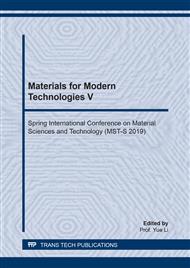[1]
T. Zhu, R. R. Li, M. F. Ma, et al. Influence of energy efficiency on VOCs decomposition in non-thermal plasma reactor. International Journal of Environmental Science and Technology, 14 (2017) 1505-1512.
DOI: 10.1007/s13762-017-1256-8
Google Scholar
[2]
M. S. Gandhi, Y. S. Mok. Decomposition of trifluoromethane in a dielectric barrier discharge non-thermal plasma reactor. J. Environ. Sci., 24 (2012) 1234-1239.
DOI: 10.1016/s1001-0742(11)60935-2
Google Scholar
[3]
L. Guo, N. Jiang, J. Li, et al. Abatement of mixed volatile organic compounds in a catalytic hybrid surface/packed-bed discharge plasma reactor. Frontiers of Environmental Science & Engineering, 12 (2018) 15.
DOI: 10.1007/s11783-018-1017-z
Google Scholar
[4]
M. Zangouei, B. Haynes. The role of atomic oxygen and ozone in the plasma and post-plasma catalytic removal of N2O. Plasma Chemistry and Plasma processing, 39 (2019) 89-108.
DOI: 10.1007/s11090-018-9926-y
Google Scholar
[5]
B. Wang, X. Xu, W. Xu, et al. Choung. The mechanism of non-thermal plasma catalysis on volatile organic compounds removal. Catalysis Surveys from Asia, 22 (2018) 73-94.
DOI: 10.1007/s10563-018-9241-x
Google Scholar
[6]
H. Yi, X. Yang, X. Tang, et al. Removal of toluene from industrial gas by adsorption-plasma catalytic process: comparison of closed discharge and ventilated discharge. Plasma Chemistry and Plasma Processing, 38 (2018) 331-345.
DOI: 10.1007/s11090-017-9863-1
Google Scholar
[7]
J. S. Chang, K. Urashima, M. Arquilla, T. Ito. Reduction of NOx from combustion flue gases by corona discharge activated methane radical injections. Combust. Sci. Technol., 1998, 133: 31-47.
DOI: 10.1080/00102209808952025
Google Scholar
[8]
Z.G. Li, Z. Hu, H.L. Xi, et al. Predictive model of decontamination efficiency of gaseous pollutant by non-equilibrium plasma. J. Electrostat., 68 (2010) 390-393.
DOI: 10.1016/j.elstat.2010.05.010
Google Scholar
[9]
Z. Li, H Zhao. Decomposition of ethanethiol by a corona radical injection system. Material Science Forum, 921 (2018) 48-53.
DOI: 10.4028/www.scientific.net/msf.921.48
Google Scholar
[10]
J.S. Chang, K. Urashima, Y.X. Tong, et al. Simultaneous removal of NOx and SO2 from coal boiler flue gases by DC corona discharge ammonia radical shower systems: pilot plant tests. J. Electrostat., 57 (2003) 313-323.
DOI: 10.1016/s0304-3886(02)00168-7
Google Scholar
[11]
K. Yukimura, T. Hiramatsu, H. Murakami, et al. Yamashita. Molar ratio and energy efficiency of deNOx using an intermittent DBD ammonia radical injection sysem. IEEE Trans. Plasma Sci., 34 (2006) 235-241.
DOI: 10.1109/tps.2006.872174
Google Scholar
[12]
K. Yukimura, K. Kawamura, S. Kambara, et al. Correlation of energy efficiency of NO removal by intermittent DBD radical injection method. IEEE Trans. Plasma Sci., 33 (2005) 763-770.
DOI: 10.1109/tps.2005.844610
Google Scholar
[13]
Y. Wu, J. Li, N. H. Wang. Study on increasing the SO2 removal efficiency with the radicals produced by H2O in pulse discharge plasma process. Jpn. J. Appl. Phys. Part2, 40(2001) 838-840.
Google Scholar
[14]
H. Lin, X. Gao, Z. Luo, et al. Removal of NOx from Flue Gas with DC Corona Radical Shower System. J. Combust. Sci. Technol., 7 (2006) 207-211.
Google Scholar
[15]
M. Sun, Y. Wu, J. L. Zhang, et al. Emission spectra of hydroxyl radical generated in air corona discharge. Spectrosc.. Spect. Anal., 25 (2005) 108-112 (Chinese).
Google Scholar
[16]
R. Li, X. Liu. Active species injection in flue gas denitrification. Chem. Eng. Sci., 55 (2000) 2481-2489.
DOI: 10.1016/s0009-2509(99)00487-x
Google Scholar
[17]
M. Magureanu, N. B. Mandache, V. I. Parvulescu, et al. Improved performance of non-thermal plasma reactor during decomposition of trichloroethylene: optimization of the reactor geometry and introduction of catalytic electrode. Appl. Cataly. B: Environ., 74 (2007) 270-277.
DOI: 10.1016/j.apcatb.2007.02.019
Google Scholar
[18]
S. J. Rubio, M. C. Quintero, A. Rodero. Application of microwave air plasma in the destruction of trichloroethylene and carbon tetrachloride at atmospheric pressure. J. Hazard. Mater., 186 (2011) 820-826.
DOI: 10.1016/j.jhazmat.2010.11.069
Google Scholar
[19]
H. X. Liu, Y. Liu, X. L. Li. Degradation of trichloroethylene in a rod-in-tube pulsed dielectric barrier discharge reactor. J. Xi'an Jiaotong University, 46(2012) 96-101 (Chinese).
Google Scholar
[20]
S. B. Han, T. Oda. Decomposition mechanism of trichloroethylene based on by-product distribution in the hybrid barrier discharge plasma process. Plasma Sources Sci. Technol., 16 (2007) 413-421.
DOI: 10.1088/0963-0252/16/2/026
Google Scholar
[21]
H. Lin, X. Gao, Z. Luo, et al. Removal of NOx with radical injection caused by corona discharge. Fuel, 83 (2004) 1349-1355.
DOI: 10.1016/j.fuel.2004.01.004
Google Scholar
[22]
S. Futamura, T. Yamamoto. Byproduct identification and mechanism determination in plasma chemical decomposition of trichloroethylene. IEEE Trans. Ind. Appl., 33 (1997) 447-453.
DOI: 10.1109/28.568009
Google Scholar


